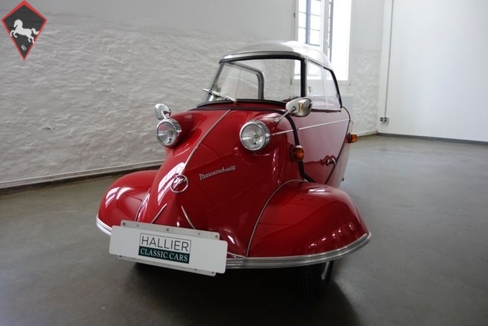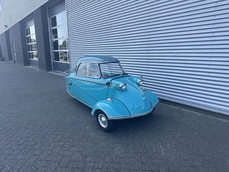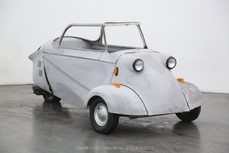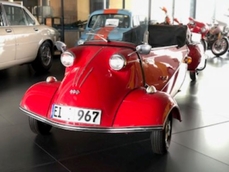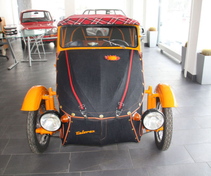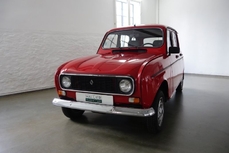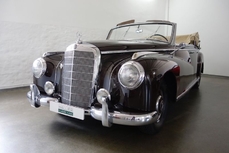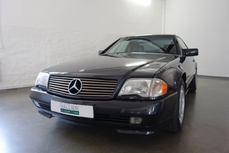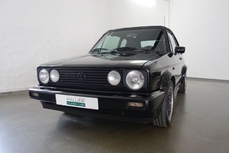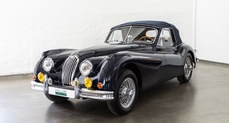Messerschmitt KR 200 KR 175, aus Sammlung 1955
General description :
Der KR 175 (KR steht für Kabinenroller) hat einen Einzylindermotor mit 173 cm³ Hubraum und 9 PS Leistung von Fichtel & Sachs. Das reichte für eine Höchstgeschwindigkeit von 80 km/h.
Dieser KR 175 ist seit über 18 Jahre in einer Hand.
Um 1999 wurde dieser Messerschmitt sehr liebevoll und umfangreich restauriert.
Nach der Restauration, stand der Messerschmitt in einer kleinen Privatsammlung und wurde hin und wieder bewegt.
Im September 2017, wurde eine Wartung, das H-Kennzeichen und eine TÜV Abnahme durchgeführt.
Heute sind die Messerschmitt Kabinenroller sehr gesucht. Besonders der KR 175 ist sehr selten.
Im Kundenauftrag
Besichtigung gern nach Terminvereinbarung
Die Fahrzeugbeschreibung ist unverbindlich, dient nur der allgemeinen Identifizierung des Fahrzeuges und stellt keine zugesicherten Eigenschaften, einen Anspruch darauf oder eine Gewährleistung im kaufrechtlichen Sinne dar. Irrtümer, Eingabefehler und Zwischenverkauf vorbehalten.
https://home.mobile.de/HALLIERCLASSICCARSGMBH#des_256221702
1955 Messerschmitt KR 200 KR 175, aus Sammlung is listed sold on ClassicDigest in Gut StellmoorDE-22926 Ahrensburg by Auto Dealer for €38900.
Car Facts
Car type : Car Make : Messerschmitt Model : KR 200 Model Version : KR 175, aus Sammlung Engine size : 0.0 Model Year : 1955 Sub type : Pick up Location : Gut StellmoorDE-22926 Ahrensburg
Sold
Seller Information
Sold
People who viewed this Messerschmitt KR 200 also viewed similar Messerschmitt listed at ClassicDigest
Other cars listed for sale by this dealer
About Messerschmitt
The transition from manufacturing fighter aircraft like the BF109 to producing three-wheeled bubble cars is a fascinating chapter in the history of the German company Messerschmitt. After World War II, with the restrictions on Germany's ability to produce traditional aircraft, companies involved in aviation had to find alternative ways to survive. Messerschmitt, led by Willy Messerschmitt, was no exception.Transition to Bubble Cars:
Post-War Restrictions:
After Germany's defeat in World War II, the country faced severe restrictions on military production. Companies involved in wartime aircraft manufacturing had to diversify their production to survive.
Messerschmitt Company Background:
Messerschmitt, known for its wartime aircraft, including the famous BF109 fighter, was initially prohibited from producing aircraft. Willy Messerschmitt, the founder, faced challenges in maintaining his company's relevance.
Microcar Concept:
In 1952, Messerschmitt collaborated with engineer Fritz Fend to produce small, economical vehicles known as microcars. These vehicles were designed to meet the demand for affordable transportation in post-war Germany.
Messerschmitt Kabinenroller (Cabin Scooter):
The first microcar produced by Messerschmitt was the Kabinenroller (Cabin Scooter), introduced in 1953. It was a three-wheeled, tandem-seated vehicle with a distinctive bubble-shaped canopy. The driver sat in the front, and the passenger sat behind.
Success of the Kabinenroller:
The Messerschmitt Kabinenroller gained popularity for its unique design and fuel efficiency. It became one of the most iconic microcars of its time.
Variants and Models:
Messerschmitt produced several variants of the Kabinenroller, including the KR175 and KR200 models. These microcars featured a narrow track, lightweight construction, and a clear bubble canopy. They were powered by small displacement engines, often motorcycle engines.
Tandem Seating and Canopy:
The tandem seating arrangement and the distinctive bubble canopy were characteristic features of Messerschmitt microcars. The bubble canopy hinged forward for entry and exit.
Market Impact:
Messerschmitt microcars were well-received in the market, especially in the context of post-war fuel shortages and economic constraints. They became a symbol of practical transportation for the masses.
End of Production:
Messerschmitt continued to produce microcars until 1964. Changes in market demands, increasing competition, and the availability of more conventional small cars contributed to the end of the Kabinenroller's production.
The transition from manufacturing fighter planes to microcars by Messerschmitt reflects the adaptability of industrial companies in post-war Europe. The Kabinenroller microcars, with their distinctive design, remain an intriguing part of automotive history.
